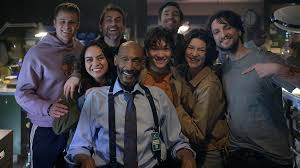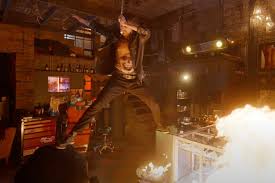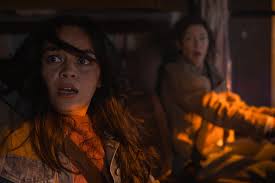Final Destination: Bloodlines — A Fresh Take on a Long-Running Curse
Introduction
The Final Destination franchise has always thrived on one simple but chilling concept: death is inevitable, and attempts to outsmart it only delay the inevitable. After a long silence, the series returned with Final Destination: Bloodlines, a film that reinvents the formula while staying faithful to what made the earlier entries so unforgettable.

This sixth installment pushes the boundaries by exploring the terrifying idea that death’s design doesn’t just stop with the survivors of a single disaster — it continues to haunt their descendants. By weaving family legacy into the familiar structure of premonitions, chain reactions, and elaborate death sequences, the film feels both familiar and newly unsettling.
At its heart, Bloodlines is a story about inherited trauma, guilt, and the illusion of control, but it never forgets to deliver the franchise’s signature scares. What follows is a detailed exploration of the movie’s story, themes, strengths and weaknesses, production, and the impact it has had on the series as a whole.
Where It Fits in the Franchise
The Final Destination films have always centered around one idea: someone experiences a vivid premonition of disaster, manages to save a group of people from a horrific accident, and then watches in horror as death comes for them one by one.
Over the years, audiences grew to expect elaborate set-pieces — everyday objects turning lethal, chance events forming intricate chains of destruction, and a sense of dread in even the most mundane environments. Yet after the fifth film, many wondered if the series had run its course.
Bloodlines proves otherwise. By introducing a generational twist, it re-energizes the franchise. This time, the survivors of the past are not the only ones marked — their children and grandchildren are also targeted. The scope is larger, the terror more personal, and the mythology richer.

Plot Essentials (Spoiler-Light)
The movie begins decades in the past, during the grand opening of a modern tower restaurant in the late 1960s. Amid the celebration, Iris Campbell experiences a horrifying vision: the structure collapsing, gas leaks igniting, a catastrophic chain of destruction. Her frantic warnings avert the tragedy, saving countless lives. But in doing so, she sets something darker in motion.
Years later, Iris’s granddaughter, Stefani Reyes, begins to experience disturbing nightmares that echo the disaster her grandmother once foresaw. As she digs into family history, she discovers journals, recordings, and fragmented memories that reveal a terrifying truth: death never forgot the lives that were spared, and now it is hunting their descendants.
The film follows Stefani, her brother, and extended family as they attempt to understand and escape the relentless grip of fate. Ordinary objects — ceiling fans, water pipes, household appliances — become ticking time bombs in elaborate sequences. The sense of inevitability builds as Stefani races to unravel the rules her grandmother tried to document.

The climax ties together past and present, forcing the family to confront not only death’s design but also the bonds that tie them together. As always with this series, the struggle is less about triumphing over death and more about seeing how far human will can stretch against inevitability.
What Bloodlines Does Differently
Every Final Destination film must strike a balance between honoring tradition and offering something new. Here’s how Bloodlines distinguishes itself:
Generational Focus
Previous entries centered solely on those who escaped the initial disaster. This time, the curse extends to blood relatives, making survival not only a personal battle but a family legacy.Emotional Core
Relationships between grandparents, parents, and children play a bigger role. Instead of simply watching strangers fight for survival, the film grounds its terror in love, guilt, and family ties.Expanded Mythology
Through Iris’s journals and Stefani’s research, the “rules” of death’s design are fleshed out in greater detail. There is a clearer sense of how fate operates and why survival may be temporary at best.

Modern Visuals
Advances in effects allow for death sequences that are both more elaborate and disturbingly realistic. Practical stunts combined with digital work create moments of visceral intensity.Slow-Burn Suspense
Unlike earlier entries that plunged straight into carnage, Bloodlines builds tension gradually, investing time in character development before unleashing its horrors.
Cast, Direction, and Production
The film is led by a fresh cast anchored by a strong protagonist in Stefani Reyes, who is portrayed with a balance of vulnerability and determination. Her relationships with her brother and grandmother provide much of the emotional backbone.
The direction emphasizes suspense over cheap shocks, with a focus on foreshadowing. A glass of water left on a counter, a loose nail, a flickering light — each detail is filmed with unsettling attention, daring the audience to predict which harmless object will become deadly.

Cinematography highlights both sweeping disaster sequences and intimate family moments, ensuring the horror is never detached from emotion. Editing keeps tension tight, lingering on near misses before delivering final blows.
What Works Well
Inventive Death Sequences
True to franchise tradition, the deaths are shocking, elaborate, and meticulously designed. They balance horror with dark creativity.Emotional Depth
By centering on family bonds, the film makes viewers care about the characters beyond the spectacle of their fates.Polished Production
Sound, lighting, and set design all contribute to a heightened sense of dread. Small noises and visual cues foreshadow larger terrors.Stronger Mythology
Fans who wanted more clarity about the “rules” of death’s design finally get deeper insight.Effective Pacing
The gradual build allows suspense to mount before chaos takes over, keeping audiences engaged from start to finish.
Potential Weaknesses
Familiar Formula
At its core, the film still follows the established blueprint: premonition, survival, inevitable deaths. For some, this may feel repetitive.Predictability
The careful foreshadowing sometimes makes certain deaths easy to guess, reducing surprise.Uneven Characterization
While main characters are well developed, some family members serve mostly as fodder for death sequences.Exaggeration
The elaborate nature of the accidents may stretch believability for viewers seeking grounded horror.Bleak Tone
The inevitability of death leaves little room for hope, which some audiences may find frustrating.

Themes and Symbolism
Beyond its scares, Bloodlines explores several deeper ideas:
Fate vs Free Will
The movie questions whether survival is ever truly a choice or simply a delay of destiny.Inherited Trauma
Actions of one generation ripple into the next, showing how the past never truly dies.Family Bonds
Love, estrangement, and reconciliation are central, reminding us that survival is about more than just the self.Mortality and Meaning
The film invites reflection on how we live knowing death is inevitable.The Weight of Time
Spanning decades, the story shows how consequences echo across eras.
Audience Reception
Viewers have responded strongly to the film’s blend of franchise familiarity and new twists. Many praise its balance of emotional storytelling and horror spectacle. The elaborate death traps satisfy fans, while the generational storyline brings fresh relevance.
Its financial success shows that audiences remain hungry for intelligent horror that both entertains and provokes thought. For long-time fans, it feels like a worthy continuation; for newcomers, it offers an accessible entry point without requiring deep knowledge of earlier films.

Strengths vs Weaknesses
| Strengths | Weaknesses |
|---|---|
| Fresh generational twist | Familiar structure may feel repetitive |
| Strong emotional core | Some characters underdeveloped |
| Polished visuals and sound | Occasional predictability |
| Clearer mythology | Elaborate deaths may feel exaggerated |
| Effective suspense building | Bleak inevitability may frustrate |
Technical Highlights
Foreshadowing through Detail: Objects filmed innocuously later become lethal, keeping viewers anxious.
Sound Design: Creaks, clicks, and silence heighten suspense.
Editing: Near misses stretch tension before final payoffs.
Cinematography: Balances intimate family scenes with large-scale chaos.
Practical Effects: Grounded realism makes the horror more impactful.
Why It Matters
Final Destination: Bloodlines is more than a horror sequel. It proves that even after years of absence, the franchise can reinvent itself while staying true to its roots. It reminds audiences why the fear of inevitable death resonates so deeply — and why the ordinary world feels more dangerous after watching.
By combining family legacy with franchise tropes, it shows how horror can be both visceral and meaningful. It also reasserts the series as a cornerstone of modern supernatural thrillers.
Who Will Enjoy It
Fans of the franchise craving new twists on familiar terror
Horror lovers who appreciate elaborate, creative death scenes
Viewers interested in stories about family, legacy, and inherited trauma
Audiences who enjoy polished, suspense-driven filmmaking
Who Might Not
Viewers seeking hopeful or uplifting horror
Those who dislike gore or elaborate death sequences
Audiences who prefer subtle, grounded scares
Fans tired of the inevitability trope
Final Thoughts
Final Destination: Bloodlines is a chilling reminder that fate can’t be escaped, only delayed. By expanding the mythology to include descendants and family ties, it breathes new life into a formula that might otherwise have felt worn. Its elaborate death traps deliver the spectacle fans crave, while its emotional grounding ensures the terror resonates more deeply.
For long-time fans, it feels like the evolution they hoped for. For new viewers, it offers a suspenseful, polished, and accessible horror experience. Ultimately, it proves that the shadow of death can still haunt audiences — and that the Final Destination legacy is far from over.
FAQs
1. Do I need to watch previous films to understand Bloodlines?
No. While fans of the series will appreciate connections, newcomers can follow the story without prior knowledge.
2. Is the movie focused only on gore?
Not at all. While elaborate death sequences are central, the film also emphasizes emotional storytelling and family relationships.
3. How scary is it compared to earlier films?
It builds suspense more gradually, but when the deaths occur, they are among the most intense in the franchise.
4. Does death always win?
The series thrives on inevitability, and this installment remains faithful to that theme.
5. What makes Bloodlines different from earlier entries?
Its focus on generational consequences and family legacy gives it a unique emotional depth.
6. Is it worth watching for longtime fans?
Yes. It honors the franchise while offering fresh twists, making it both familiar and surprising.
